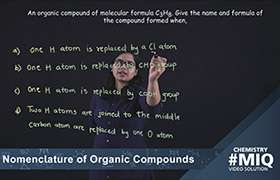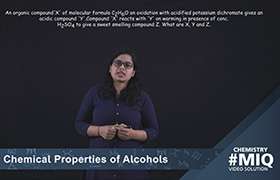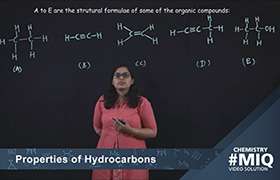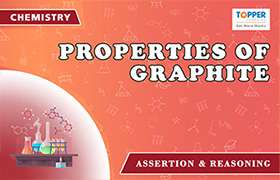CBSE Class 10 Answered
IUPAC System
IUPAC nomenclature of aliphatic compounds:
According to the IUPAC system of nomenclature, the name of an organic compound consists of the following three parts:
- Word root
- Suffix
- Prefix
Word Root
The word root represents the number of carbon atoms in the parent chain and it is the basic unit of the name. The parent chain is selected as per the longest chain rule i.e., the parent chain is the longest continuous chain of C-atoms including the functional group and the multiple bonds, if any.
For the carbon chains up to four carbon atoms, special word roots based on their common names are used. For chains consisting of five or more carbon atoms, the word roots are derived from the Greek numerals as shown in table. The general word root for any carbon chain is alk. The word roots for the chains consisting of different number of carbon atoms are listed below:
Word roots for different lengths of carbon chains
|
Chain length |
Word root * |
Chain length |
Word root * |
|
C1 |
Meth |
C8 |
Oct |
|
C2 |
Eth |
C9 |
Non |
|
C3 |
Prop |
C10 |
Dec |
|
C4 |
But |
C11 |
Undec |
|
C5 |
Pent |
C12 |
Dodec |
|
C6 |
Hex |
C13 |
Tridec |
|
C7 |
Hept |
C18 |
Octadec |
* an extra 'a' is added to the word root if the primary suffix to be added to the word root begins with a consonant
Suffix:
There are two types of suffixes.
Primary suffix
A primary suffix is added to the word root (i.e., at the end of the word root) to indicate whether the parent chain is a saturated or unsaturated. Some primary suffixes are given below.
- Saturated - ane
- Unsaturated with: one double bond - ene
two double bonds - diene
three double bounds - triene
- Unsaturated with: one triple bond - yne
Two triple bond - diyene
Primary suffix on appropriate word root for some typical compounds are:
|
Formula of the organic compound |
‘C’ - atoms in parent chain |
Word root |
Primary suffix |
IUPAC name |
|
CH3CH2CH2CH3 |
4 |
But |
ane |
Butane |
|
CH3CH= CH2 |
3 |
Prop |
ene |
Propene |
|
CH≡ CH |
2 |
Eth |
yne |
Ethyne |
|
CH2 = CH - CH = CH2 |
4 |
Buta* |
diene |
Butadiene |
|
HC≡ C - C≡ CH |
4 |
Buta* |
diyne |
Butadiyne |
* An extra 'a' has been added to the word root since the primary suffix i.e., diene or diyne begins with consonant i.e., 'd' instead of a vowel as is the case in the first three cases.
Secondary suffix:
Secondary suffix is used to indicate the function group in the organic compound. Secondary suffixes for various functional groups are given in the table below.
|
Family of organic compounds |
Functional group |
Secondary suffix |
||
|
IUPAC names |
Trivial names |
|
|
|
|
Alkanols |
Alcohols |
(ROH) |
- OH |
-ol |
|
Alkanals |
Aldehydes |
(RCHO) |
- CHO |
-al |
|
Alkanones |
Ketones |
(RCOR') |
>C = O |
-one |
|
Alkanoic acids |
Carboxylic acids |
(RCOOH) |
- COOH |
-oic acid |
|
Alkanmides |
Acid amides |
(RCONH2) |
- CONH2 |
-amide |
|
Alkanoyl chlorides |
Acid chlorides |
(RCOCl) |
- COCl |
-oyl chloride |
|
Alkyl alkanoates |
Esters |
(RCOOR') |
- COOR |
-alkyl...oate |
|
Alkanenitriles |
Cyanides |
(RCN) |
- CN |
nitrile |
|
Alkanthiols |
Thioalcohols |
(RSH) |
- SH |
thiol |
|
Alkanarnines |
Amines |
(RNH2) |
- NH2 |
amine |
Secondary suffix is written after the primary suffix. While doing so, the following rules should be followed.
If the secondary suffix begins with a vowel, then the terminal e of the primary suffix is dropped before adding the secondary suffix.
If the secondary suffix begins with a consonant, then the last (terminal) e is retained and the secondary suffix is added after e.
If the secondary suffix has some numerical prefix, such as, di, tri etc., before it then the terminal e of the primary suffix is retained.
The addition of the secondary suffix to the primary suffix is illustrated as:
|
Formula of compound |
C - atoms (parent chain) |
Word root |
Primary suffix |
Secondary suffix |
IUPAC name |
Remarks |
|
CH3CH2CH2COOH |
4 |
But |
ane |
Oic acid |
Butaroic acid |
'e' of primary suffix removed |
|
CH3CH2CN |
3 |
Prop |
ane |
Nitrile |
Propenenitrile |
'e' of primary suffix not removed |
|
CH2 - OH | CH2 - OH |
2 |
etn |
ane |
Diol |
Etharediol |
'e' of primary suffix not removed |
Prefix:
Prefix is a part of the name, which appears before the word root. There are two types prefixes:
Primary prefix:
A primary prefix is used to distinguish alicyclic (aliphatic cyclic compounds) from acylic compounds. A prefix cyclo is used before the word root if the compound is an alicyclic compound. For example,
Cyclopentane:
If the prefix cyclo is absent, in an acylic compound it indicates an open chain compound.
Secondary prefix:
In the IUPAC system of nomenclature, groups are not considered as functional groups (which are indicated by secondary suffixes) but as substituents. Each such group (or substituent) is denoted by a secondary prefix. Some typical secondary prefixes are:
|
Substituent group |
Secondary prefix |
|
- F |
Fluoro |
|
- Cl |
Chloro |
|
- Br |
Bromo |
|
- I |
lodo |
|
CH3 - |
Methyl |
|
C2H5 |
Ethyl |
|
CH3CH2CH3 - |
n-propyl |
|
(CH3)2CH - |
iso-propyl |
|
(CH3)3C - |
t-butyl |
|
- NO2 |
nito |
|
- NH2 |
amino |
|
- NO |
nitroso |
|
- N ≡ N + |
diazo |
|
- OCH3 |
methoxy |
|
- OC2H5 |
ethoxy |
|
- OR |
alkoxy |
Groups such as -NO2, -OR, -F, -Cl, -Br and -I are considered as substituents and are indicated by the prefixes. Groups such as -CHO, -CO, -COOH, -COCl, -CONH2, -COOR, -NH2, -CN and -OH are considered as functional groups and are indicated by suffixes.
The following rules should be observed while adding a secondary prefix.
- In the case of alicylic compounds (aliphatic cyclic), the secondary prefix is added before the primary prefix (before the word cyclo), in the alphabetical order.
- In the case of open chain compounds (acyclic), the secondary prefix is added just before the word root in the alphabetical order.
Nitromethane : CH3NO2
Thus, the name of an organic compound can be obtained by writing the word root, prefixes and suffixes in the following order as per rules described.
Secondary prefix + Primary prefix + Word root + Primary suffix + Secondary suffix.











